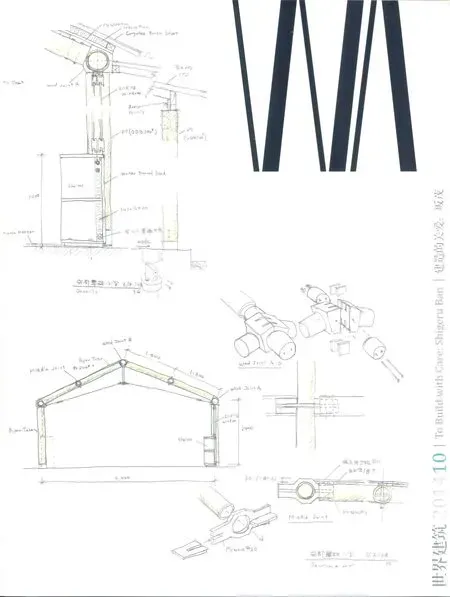建造创新与社会关怀
——坂茂访谈
范路,张利/FAN Lu, ZHANG Li
建造创新与社会关怀
——坂茂访谈
Constructing Innovation and Social Care: An Interview with Shigeru Ban
范路,张利/FAN Lu, ZHANG Li

坂茂/Shigeru Ban
出生
1957年8月5日,日本东京
教育背景
1977-1980 南加州建筑学院
1980-1982 库珀联盟建筑学院
1984 获库珀联盟建筑学院建筑学学士学位
工作经历
1982-1983 矶崎新工作室,东京
创办机构
1985 在东京成立私人工作室
1995 创立非政府组织——建筑师志愿者网络(VAN)1995-1999 联合国难民事务高级专员顾问
执教生涯
1993-1995 多摩美术大学建筑系兼职教授
1995-1999 横滨国立大学建筑系兼职教授
1996-2000 日本大学建筑系兼职教授
2000 哥伦比亚大学客座教授
哥伦比亚大学康纳德·基恩中心访问学者
2001-2008 庆应义塾大学教授
2010 哈佛大学客座教授
康奈尔大学客座教授
2011- 京都艺术与设计大学教授
获得荣誉
2001 时代杂志年度创新人物
2004 美国建筑师学会荣誉资深会员(HFAIA)2005 英国皇家建筑师学会国际奖学金(IFRIBA)
阿默斯特学院人文学荣誉博士
2006 加拿大皇家建筑师学会荣誉院士
2006-2009 普利兹克建筑奖评委会成员
2009 慕尼黑工业大学名誉博士学位
2010 法国艺术与文学学院硕士
2011 法国国家荣誉勋章
2014 库珀联盟名誉博士学位
2014 普利兹克建筑奖
Born
August 5,1957, Tokyo, Japan
Education
1977-1980 Southern California Institute of Architecture 1980-1982 Cooper Union School of Architecture
1984 Received Bachelor of Architecture from Cooper Union
Worked
1982-1983 Arata Isozaki, Tokyo
Founded
1985 Established private practice in Tokyo
1995 Established NGO, Voluntary Architects' Network (VAN)
1995-1999 Consultant of United Nations High Commissioner for Refugees (UNHCR)
Teaching
1993-1995 Adjunct Professor of Architecture at Tama Art University
1995-1999 Adjunct Professor of Architecture at Yokohama National University
1996-2000 Adjunct Professor of Architecture at Nihon University
2000 Visiting Professor of Columbia University Visiting Fellow of Donald Keen Center, Columbia University
2001-2008 Professor of Keio University
2010 Visiting Professor of Harvard University GSD Visiting Professor of Cornell University
2011- Professor, Kyoto University of Art and Design Recognition
2001 Time Magazine Innovator of the Year
2004 Honorary Fellow of the American Institute of Architects (HFAIA)
2005 International Fellowship of the Royal Institute of British Architects (IFRIBA)
Honorary Doctor of Humane Letters Amherst College
2006 Honorary Fellow of the Royal Architectural Institute of Canada (HRAIC)
2006-2009 Jury Member of the Pritzker Architecture Prize
2009 Honorary Doctorate of Technical University of Munich
2010 l'Ordre des Arts et des Lettres in France
2011 l'Ordre National du Mérite in France
2014 Honorary Doctorate of Cooper Union
2014 The Pritzker Architecture Prize
WA:您在许多项目中,常常将纸管、啤酒箱或集装箱当作基本的建筑要素使用。您在设计中运用这些现成工业产品的态度,是否得益于在南加州建筑学院(SCI-Arc)的求学经历和当时加州波普艺术的美学?
坂茂:我想并没有这种联系。
WA:纸管是您非常喜爱使用的建筑材料。它们价格便宜,随处可得。除此之外,使用它们是否还有其他好处,例如纸管适合不同类型的节点或在视觉上具有某种韵律感?
坂茂:我喜爱所有材料,甚至是混凝土和钢材。纸管的优点还包括轻质。这样即使是学生也能完成建造工作。当然,它也创造了完全不同的建筑形式。
WA:当把纸管从一个国家运到另一个国家时,运输费是否会超过在另一国当地购买建材的费用?
坂茂:我从未运输纸管,除了在台湾纸教堂项目中,纸管是迁移自神户。然而在该项目中,尽管使用台湾当地的纸管会更便宜些。但对台湾地震的受害者来说,再次使用为神户地震受害者建造的纸教堂,表达了重要的信息和意义。
WA:无论是人道主义项目还是标志性建筑,您总是关注建筑材料和结构的创新。在这两类不同的项目中,您的设计创新策略会有什么不同?
坂茂:其实并没有什么不同。
WA:在您的设计中,还常常能看到内外空间的连续性和半透明界面产生的神奇氛围。这些设计主题是否来自日本传统的住宅空间?
坂茂:可以说是,也可以说不是。在许多不同的文化中——西方的、伊斯兰的等等,都有这种之间的空间(in between spaces)存在。
WA:您在中国有两个项目——成都华林小学临时校舍和四川芦山县的苗苗幼儿园。在这两个项目的建造过程中,您有没有遇到过特殊的困难?
坂茂:有的。在华林小学项目中,一家当地公司生产的木榫头并不合格。那些木榫头本应该是实心的,但实际上却是空心的。
WA:在韩国高尔夫俱乐部、法国蓬皮杜梅斯中心和瑞士苏黎世Tamedia新办公大楼中,创新性的木结构颇具表现力。在些项目的结构设计中,您是如何与结构工程师进行合作的?
坂茂:从这些项目一开始,我都是与一位瑞士木结构工程师赫尔曼·布鲁默(Hermann Blumer)合作。WA:您还十分重视项目中的家具设计,经常花精力设计用于储藏和展示的格架。是否这意味着您十分关注建筑中发生的日常生活?
坂茂:是的。我愿意亲自设计所有的东西。
WA:让人道主义项目更有说服力的一个要素是其长期的社会效果。在您的人道主义项目中,您是否追踪过长期的使用效果?如果有的话,结果如何?
坂茂:项目完成后过段时间,我常常会去回访。而维护是十分必要的。
WA:我们生活在一个讲究政治正确的时代。在当代建筑中,是否政治正确被过于看重?
坂茂:我想我从没考虑过这一点。
WA: Paper tubes, beer crates and containers are often used as fundamental architectural elements in your projects. Does your attitude towards these ready-made products benefit from your educational experience in SCI-Arc and Pop Art aesthetics in California?
Ban: No.
WA: Paper tubes are your favourite building material. Besides they are cheap and available everywhere, are there any other advantages for using them, such as suitable for different types of joint or rhythmical image?
Ban: I like any material even concrete and steel. Other advantage of paper tube is light weight, so that the construction can be done even by students. Also it creates totally different type of architectural forms.
WA: When paper tubes are transported from one country to another, will the freight cost more than the expense of buying local materials?
Ban: I never transport paper tube except the Paper Church in Taiwan relocated from Kobe. Although it should be cheaper to use locally available paper tube in Taiwan, at this time it has other important message and meaning to re-use Paper Church used for the victims of the Kobe earthquake for the victims of the Taiwan earthquake.
WA: In both humanitarian work and monumental projects, innovation related to building materials and structures is always your focus. But what is the difference between innovative strategies in those two types of projects?
Ban: There is no difference.
WA: Spatial continuity between interior and exterior and translucent magical atmosphere are also your design themes. Do those themes come from traditional Japanese housing space?
Ban: Yes or (and) No. Those kind of in between spaces exists in many spaces of different culture, west, Islamic…
WA: In Chinese projects - Paper Temporary Chengdu Hualin Elementary School and Lushan Cardboard Tubes Kindergarten, did you get in any special troubles in construction process?
Ban: Yes. For Hualin Elementary school, the wooden joint made by a local company was a defective product. It had to be solid wood joint, but it was empty inside.
WA: In projects of Korean Golf Club House, Centre Pompidou-Metz, and Zurich Tamedia Building, how did you cooperate with structural engineers during the process of those innovative and expressive timber structures design?
Ban: I collaborated with the same Swiss timber engineer, Hermann Blumer, from the beginning of the project.
WA: Furniture design such as shelves for storage and display is also paid a lot of attention in your work. Does this express your care for everyday living in buildings?
Ban: Yes. Also I would like to design everything by myself.
WA: One element that makes humanitarian projects more convincing is the long-term social effect. Do you trace the long-term usage of your humanitarian projects? If so, what are the results?
Ban: I come back to see those projects after a while. Always maintenances are necessary.
WA: We are living in a time of political correctness. Is political correctness over rated in contemporary architecture?
Ban: I never thought about it.
清华大学建筑学院
2014-10-07

